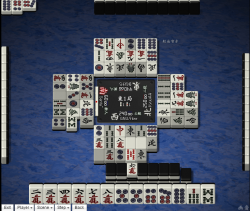Haitei raoyue and houtei raoyui
| Type | Yaku |
|---|---|
| Kanji |
海底撈月 河底撈魚 |
| English |
Win by last draw Win by last discard |
| Value | 1 han |
| Speed | Very Slow |
| Difficulty | Luck |
Haitei raoyue 「海底撈月」 (also called Haitei mouyue 「海底摸月」), or haitei for short, is a yaku scored when a player wins by tsumo on the last drawable tile from the live wall.
Houtei raoyui 「河底撈魚」, or houtei for short, is scored when a player wins by ron on the last possible discard. The discarded tile does not have to be the tile just drawn by the player.
It is possible to win even if the hand's only yaku is haitei/houtei.
Haiteihai and houteihai

The haiteihai 「海底牌」 is the very last tile that can be drawn from the regular wall. It is always the 15th tile from the end, counting the 14 tiles of the dead wall. It is typically on the bottom of its two-tile stack, but kan calls will shift the designation of the last tile. When kan is called, the current haiteihai is shifted to the dead wall (to accommodate for the rinshan draw). In some groups, the tile may physically be moved from the live wall into the dead wall to make it clearer when the hand ends, but this generally not done in professional play.
Likewise, the very last discard is called houteihai 「河底牌」. The houteihai can never be called for chii, pon, or kan.
If a player calls a kan when there is only one tile left in the live wall, haitei is not scored. Despite being the "last draw" of the game, kan draws from the dead wall, but haitei requires a draw from the live wall. The final discarded tile after a kan is still valid for houtei.
A player cannot call a kan after drawing the last tile (either normally or as a result of a kan), because they would need to draw a rinshanpai and doing so would bring the dead wall down to 13 tiles.
Development
Like any hand, both haitei and houtei requires tenpai at the very last draw/discard to be scored. At this point, any hand in tenpai can win, even an otherwise "yakuless" open hand.
Compatibility
^ Ippatsu requires riichi to be of any use.
| RCH | DRI | IPP | SMO | TAN | PFU | IPK | ITT | YAK | SDJ | SDO | TOI | SNA | SNK | CHA | JUN | RPK | SSG | HRO | HON | CHN | CHI | RIN | HAI | HOU | CHK | |
| HAI | ||||||||||||||||||||||||||
| HOU |
Haitei and houtei are mutually exclusive with each other, with chankan, and with rinshan kaihou. Each of these yaku requires the winning tile to come from a different location (the live wall, a tile added to make a shouminkan, and the dead wall, respectively). Houtei cannot combine with mentsumo because it is only winnable via discards.
As for ippatsu, it is impossible to call riichi unless there are at least 4 tiles left in the live wall. If riichi is declared with 4 tiles remaining, and no tile calls are made, then the riichi declarer will draw the haiteihai on the ippatsu draw. This allows ippatsu to be scored with haitei, but not houtei, since drawing the haiteihai means it is impossible to score houtei. While tile calls may shift the draw order, any tile call will interrupt ippatsu.
Meaning
The term haitei raoyue translates literally as "scooping up the reflection of the moon from the bottom of the sea." It is a figurative Chinese expression (sometimes used in Japanese as well) use to mean a futile task. houtei raoyui is a pun on this, translating literally as "catching fish from the bottom of the river." The kanji 河 is the term kawa, meaning the discard pond. Hence houtei is a pun referring to both haitei, and the act of catching a fish from the bottom of the discard river.
External links
- Haitei raoyue in Japanese Wikipedia
- Houtei raoyui in Japanese Wikipedia
| |||||||||||||||||||||||||||||||
